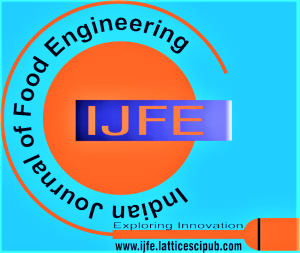![]()
Investigating the Impact of Microwave Drying on Papaya Slice Quality and Drying Attributes
Prashant Kumar1, Kailash Chandra Yadav2
1Prashant Kumar, Department of Processing and Food Engineering, SHUATS, Prayagraj (U.P.), India.
2Dr. Kailash Chandra Yadav, Department of Processing and Food Engineering, SHUATS, Prayagraj (U.P.), India.
Manuscript received on 01 December 2023 | Revised Manuscript received on 12 December 2023 | Manuscript Accepted on 15 December 2023 | Manuscript published on 30 December 2023 | PP: 7-13 | Volume-3 Issue-1 December 2023 | Retrieval Number: 100.1/ijfe.B101003020324 | 10.54105/ijfe.B1010.03011223
Open Access | Editorial and Publishing Policies | Cite | Zenodo | Indexing and Abstracting
© The Authors. Published by Lattice Science Publication (LSP). This is an open-access article under the CC-BY-NC-ND license (http://creativecommons.org/licenses/by-nc-nd/4.0/)
Abstract: Impact of microwave power and thickness of papaya slices were studied on the product quality and drying attributes of dehydrated papaya slices. Power (20, 40, 60 and 80W), thickness (3, 6 and 9mm), Moisture content, Vitamin’C’ and Iron content were determined and found i.e.M.c 24.23 to 13.25% w.b., Vitamin ‘C’ 45.55 – 45.38 mg/100g, Iron content 4 – 3.98 mg/100g. The quality and sensory attributes were determined, and it was found that the sample with the thickness of 3mm with 60W power was found highest score in overall acceptability with minimum loss of vitamin C and iron content. Drying rate, Rehydration Ratio, Ash Content were determined and found i.e., Drying Rate 0.0002 – 0.00025 g/s, Rehydration Ratio 1.85 – 1.08, Ash Content 1.80 – 1.02 %. In color parameters the product achieved dark color [L-22.48]at higher microwave power before acceptable dehydration. Where, as the sample dehydrated at slice thickness 3mm and microwave power 60 W scored acceptable color and sensory score as well as L (39.46), a (8.45) &b (15.23. The samples processed at 60 W microwaves drying had higher porosity than fresh samples analyzed by using SEM.Based on the criteria for thin-layer drying kinetics, the results reveal that, in comparison to the Henderson and Pabis, Lewis and Page model, the Singh and Wang model achieved the best values for the coefficient of determination (R2), chi-square (χ2), and reduced root-mean-square error approximation (0.01341).
Keywords: Microwave Drying, Slices thickness, Power. Seed Powder, LDPE, HDPE, LAF Packaging, Physical properties
Scope of the Article: Engineering Properties of Foods
